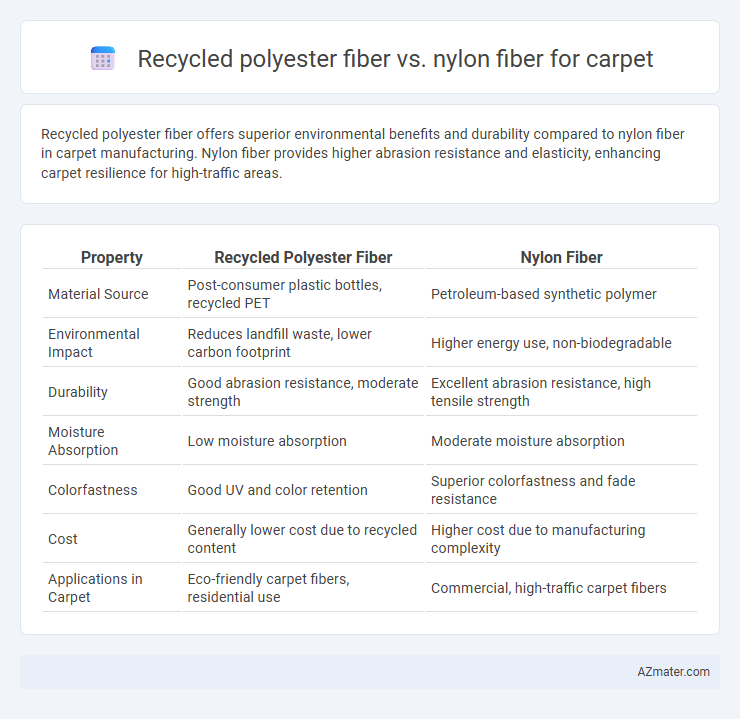Recycled polyester fiber offers superior environmental benefits and durability compared to nylon fiber in carpet manufacturing. Nylon fiber provides higher abrasion resistance and elasticity, enhancing carpet resilience for high-traffic areas.
Table of Comparison
| Property | Recycled Polyester Fiber | Nylon Fiber |
|---|---|---|
| Material Source | Post-consumer plastic bottles, recycled PET | Petroleum-based synthetic polymer |
| Environmental Impact | Reduces landfill waste, lower carbon footprint | Higher energy use, non-biodegradable |
| Durability | Good abrasion resistance, moderate strength | Excellent abrasion resistance, high tensile strength |
| Moisture Absorption | Low moisture absorption | Moderate moisture absorption |
| Colorfastness | Good UV and color retention | Superior colorfastness and fade resistance |
| Cost | Generally lower cost due to recycled content | Higher cost due to manufacturing complexity |
| Applications in Carpet | Eco-friendly carpet fibers, residential use | Commercial, high-traffic carpet fibers |
Introduction to Recycled Polyester and Nylon Fibers
Recycled polyester fiber, derived from post-consumer plastic waste such as PET bottles, offers an environmentally sustainable alternative to virgin polyester in carpet manufacturing by reducing landfill waste and energy consumption. Nylon fiber, primarily produced from petrochemical sources, is known for its superior durability, elasticity, and resistance to abrasion, making it a common choice for high-traffic carpet applications. Both fibers serve distinct performance and ecological roles, with recycled polyester prioritizing sustainability and nylon emphasizing strength and longevity.
Manufacturing Process Comparison
Recycled polyester fiber for carpets is produced by melting and re-extruding post-consumer PET bottles or polyester waste, significantly reducing energy consumption and greenhouse gas emissions compared to virgin polyester production. Nylon fiber manufacturing involves polymerizing caprolactam to form nylon 6 or hexamethylenediamine and adipic acid for nylon 6,6, which requires higher energy input and emits more volatile organic compounds (VOCs). The closed-loop processes in recycled polyester fiber production enhance sustainability by minimizing raw material extraction, whereas nylon fiber manufacture demands intensive fossil fuel derivatives and complex chemical processing.
Environmental Impact: Recycled Polyester vs Nylon
Recycled polyester fiber for carpet significantly reduces environmental impact by lowering greenhouse gas emissions and minimizing reliance on fossil fuels compared to conventional nylon fiber. Nylon production typically involves energy-intensive processes and releases more nitrous oxide, a potent greenhouse gas, whereas recycled polyester uses post-consumer plastic waste, diverting it from landfills and reducing plastic pollution. The carbon footprint of recycled polyester carpets is substantially smaller, making them a more sustainable choice in the carpet industry.
Durability and Performance in Carpeting
Recycled polyester fiber demonstrates excellent resistance to abrasion, staining, and fading, making it a durable option for high-traffic carpet areas. Nylon fiber offers superior elasticity and resilience, maintaining carpet shape and appearance even under heavy foot traffic and frequent cleaning. Both fibers provide strong performance in carpeting, but nylon typically excels in long-term wear retention while recycled polyester emphasizes sustainability.
Stain and Fade Resistance
Recycled polyester fiber offers superior stain resistance compared to nylon fiber, making it ideal for high-traffic carpet areas prone to spills and dirt. Polyester fibers also demonstrate better fade resistance under prolonged exposure to sunlight, maintaining vibrant color integrity longer than nylon. Nylon fiber, while durable, tends to absorb stains more readily and exhibits faster color degradation, reducing carpet longevity in bright or outdoor environments.
Comfort and Texture Differences
Recycled polyester fiber offers a softer, more plush texture compared to nylon fiber, making carpets feel more luxurious underfoot. Nylon fiber provides a firmer, more resilient texture that enhances durability but may lack the initial softness of recycled polyester. The comfort of recycled polyester carpets is often preferred in residential settings, while nylon is favored in high-traffic areas for its strength and resistance to wear.
Cost Analysis: Upfront and Lifecycle
Recycled polyester fiber typically offers a lower upfront cost compared to nylon fiber, making it a budget-friendly option for carpet manufacturing. Over the lifecycle, nylon fiber exhibits superior durability and resilience, which often translates into reduced replacement and maintenance expenses, enhancing long-term cost efficiency. Despite higher initial investment, nylon carpets may provide better value due to their extended lifespan and resistance to wear and staining.
Design and Color Versatility
Recycled polyester fiber offers superior design and color versatility for carpets due to its ability to hold vibrant dyes and resist fading over time, enabling a wide range of aesthetic options. Nylon fiber, while known for durability, tends to have limitations in color retention and may require special treatments to achieve similar vibrancy. The enhanced dye affinity of recycled polyester supports intricate patterns and consistent color application, making it a preferred choice for creative carpet designs.
Maintenance and Cleaning Requirements
Recycled polyester fiber in carpets offers superior stain resistance and easier maintenance compared to nylon fiber, as it repels moisture and resists dirt buildup. Nylon fibers typically require more frequent deep cleaning and specialized treatments to prevent color fading and fiber degradation. Regular vacuuming and prompt stain treatment are essential for both fibers, but recycled polyester's durability reduces overall cleaning intensity and frequency.
Which Fiber is Best for Sustainable Carpeting?
Recycled polyester fiber outperforms nylon fiber in sustainable carpeting by significantly reducing environmental impact through the use of post-consumer plastic bottles and lower carbon emissions in production. Nylon fiber, while durable and resilient, relies heavily on petrochemical resources and consumes more energy, making it less eco-friendly compared to recycled polyester. Incorporating recycled polyester fiber in carpets supports circular economy practices and aligns with global sustainability goals in the flooring industry.

Infographic: Recycled polyester fiber vs Nylon fiber for Carpet
 azmater.com
azmater.com